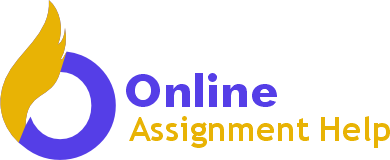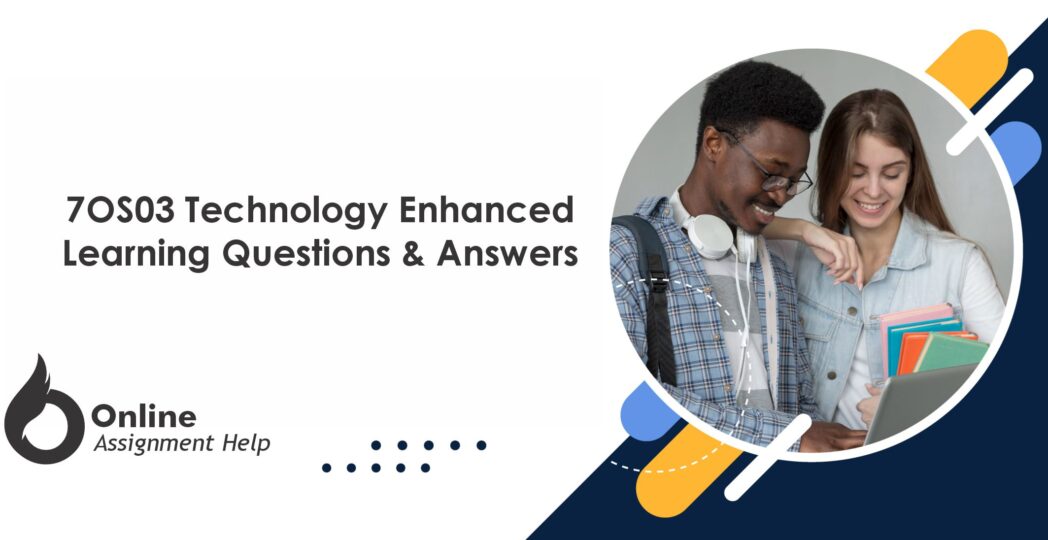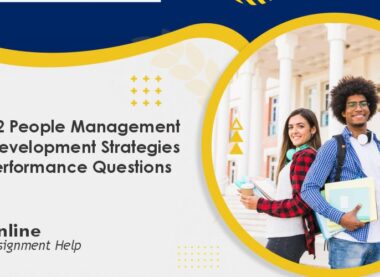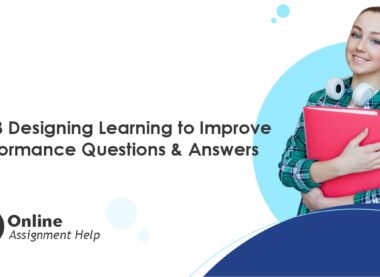Table of Contents
7OS03 Technology Enhanced Learning Questions & Answers
Task 1 – Report
LO1: Understand major technological developments and their impact upon the design and practice of learning and development
LO2: Understand a variety of technological solutions and the relevance within learning and development
LO3: Understand the implementation of learning technologies within organisations
TechCo are a large private sector telecommunications company providing mobile and fixed line B2B and B2C services. TechCo employ C. 2000 colleagues and traditionally around 70% have been based in their head office, with the remaining 30% working remotely in roles such as service engineers.
The landscape is changing, and the market is increasingly competitive. TechCo see an opportunity to revisit their current systems in the wider business to address growing concerns around people and ensuring that the organisation has the right skills in place for the future. eLearning has been a core part of the learning and development provision in TechCo for the past 10 years but there has been little
investment in these systems, and it is unknown what L&Ds impact is within the organisation. Data is limited, not helped by the lack of investment in the current LMS. There is also no active management of this system aside from uploading new regulatory courses.
You are one of the People Partners in TechCo and you have been tasked with researching and proposing ways in which TechCo can effectively use technology to enhance its learning offer. Your People Director would like recommended changes to contribute to the following strategic KPIs:
- Improved employee net promoter score
- Reduced turnover
- Increase in future ready skills
Your task is to produce a report for the senior leadership team which outlines your research and recommendations for enhancing the learning and development provision at TechCo.
Your report can be structured under the sections below and must include the following areas:
Section 1
- A discussion of future trends impacting the role of technology within learning. Select two emerging technology trends and assess the extent to which these are being used and the benefits they might bring.
- Present an analysis of how TechCo could best use technology to:
o Assess learning needs
o Design and deliver learning
o Assess the impact of learning
Section 2
- Critically evaluate how technological systems are used in three different organisations and how they support learning in each instance.
- Using the same examples and/or other research examples, assess the impact of different learning media and delivery on participant engagement.
- Based on your analysis so far, develop a set of recommendations for TechCo with clear rationale for your choices.
Section 3
- Present an implementation plan and critically discuss:
o The key stages of the implementation process
o The barriers which TechCo might face and your suggestions on how to mitigate against these.
- Justify your thinking using wider reading.
Task 2 – Briefing Paper
LO4: Understand the role of data in improving the effectiveness of organisational learning and development provision
Your People Director would like a briefing paper with recommended changes based on the following areas :
- Discuss the ways in which learning analytics and metrics can improve the effectiveness of learning and development.
- Determine appropriate data sources and metrics which TechCo could use to achieve improved effectiveness.
7OS03 Assignment Answers
Task 1 – Report
Introduction
The scenery of learning is going through a deep change facilitated by increased developments in technology. Future trends like Extended reality, Artificial Intelligence, as well as systems of personalised learning are transforming conventional teaching and learning techniques. Notably, these technologies provide innovative solutions to handle the changing preferences and necessities of both learners and educators. The following report will address this topic of technological advancements and offers recommendations for TechCo.
SECTION 1
Future Trends Impacting the Role of Technology in within Learning
The scenery of learning and education is being redesigned by intensified technological developments with emerging trends playing a crucial part in transforming conventional learning and teaching techniques. Some of these techniques include Artificial Intelligence (AI), gamification and game-based learning, Extended Reality, and personalised and adaptive learning systems. According to Beer and Mulder (2020), these technologies provide innovative solutions to deal with the changing needs and preferences of educators and learners, offering prospects for personalised experiences of learning, improved involvement, and immersive simulations. As institutions of learning alter to the epoch of technology breakthroughs, the degree to which these innovations are utilised and the advantages offered by these technologies are turning to be increasingly external.
Artificial Intelligence (AI)
This emerging technology happens to be transforming different elements of learning, from creation of content and information to analytics and assessments. Adaptive forums of learning, supported by algorithms of AI, are obtaining admiration for their potential to offer personalised experiences of learning designed to the preferences and needs of learners. These forums analyse the data on the performance of learners and alter the content and provision of instruction in the right way, increasing retention of knowledge and engagement. Nevertheless, assessing the degree of integration of AI in learning contexts may appear to be challenging because of the different degrees of implementation and the intricacy of the systems of AI (Dakhi et al., 2020). AI has various benefits in learning which go beyond automated evaluations, where tools powered by the technology can analyse huge sets of data of the responses of learners to offer immediate feedback and discover areas where further backing may be required.
Extended Reality (XR)
This technological advancement encompasses both AR and VR. It happens to be changing the environments of learning into experiential and immersive spaces. Simulations of Virtual reality provide hands-on opportunities of training in areas like manufacturing, engineering, and medicine, where actual-world application tends to be impractical or expensive. According to Ahmed et al. (2020), learners can be involved in scenarios that are realistic and undertake multifaceted roles in a controlled and safe environment, minimising the peril of accidents and reducing the necessity for costly physical resources or equipment. Similarly, applications of AR overlap digital content onto the physical surrounding, improving conventional materials of learning and instigating interactive experiences. Nevertheless, implementing these technologies needs investment and use of a lot of resources in specialised development of software, hardware, and training for instructors, which may become a challenge for institutions of education with restricted budgets or out of date infrastructure (Raschka et al., 2020). The benefit of the technology is that by connecting the space between actual-world application and theoretical knowledge, XR technologies help learners to use ideas and concepts in practical settings, promoting more profound development of skills and comprehension. Furthermore, the immersive nature of the experiences of AR and VR captivate the attention of learners and promotes active engagement, resulting in increased degrees of motivation and engagement.
How TechCo could best Use Technology to:
Assess Learning Needs
According to TechCo’s evaluation of the learning needs, administering diagnostic methods on the e-Learning management system (LMS) or on a Learning Experience Platform (LXP) can be a helpful tool in gaining information regarding the employees’ technical and soft skills. These diagnostic evaluations offer a choice between self-assessments and competency-based assessments thereby people are able to identify their potentials and excellence areas. To begin with, the deployment of AI algorithms along with the assessment process will cause TechCo to use data from different sources, including performance reviews, skills assessments, and employee feedback, to identify employees’ training needs across the whole organisation (Ahmad et al., 2022). Through those insights, TechCo can come up with specially adapted learning interventions addressing particular skill shortages with respect to organisational objectives and personal development areas, consequently, bringing training in line with the company goals and individual needs.
Design and Delivery of Learning
The mixing of both private learning and public learning platforms in TechCo’s educational organisation provides the users a large variety of resources to get hold of. According to Akhtar et al. (2022), private platforms have bite size assimilable content of the company and material thus they can host internally developed content, proprietary training materials, and company-specific resources, whereas public platforms offer industry certifications, online courses, and expert-led training sessions for people who has been own or run their own business. Moreover, LCMS helps TechCo to create, coordinate, and find learning content effectively using a search engine or other means of categorisation. Also, learners having the freedom of generating and sharing learner-generated content will be helpful in developing the culture of the knowledge sharing equivalent as well as peer-to-peer learning which in turn will enrich the whole learning experience.
Impact Assessment of Learning
An accurate gauge of the outcome of learning initiatives at TechCo must involve tracking learner engagement metrics and measuring achievement scores. Through measuring the rates of course completion, test grades, and the time students spend on learning activities, TechCo can appraise the training programs and find the weak points (Dewi et al., 2021). Also, deploying technology tools in the workplace which can be used to measure return on training and how this translates to business outcomes for instance performance management systems and project management tools are a great way to do so. Connecting learning achievements to key performance indicators is a way TechCo can show how powerful learning initiatives are when it comes to boosting the productivity of the employees, accomplishment of the customers and general growth of the organisation.
SECTION 2
Critical Evaluation of how Technological Systems are Used in Companies.
AcmeTech, as a top software development company, based on its unique Learning Management System (LMS) ensuring learning needs of its employees. The company has designed and develop its LMS, which is referred to as AcmeLearn. This platform serves as a centralised software for storing and administering various learning materials, such as technical training, coding instructions, and project management. AcmeLearn provides a series of services including individualised curricula, practical assessments and networking resources fitting into a workplace where employees can expand their capabilities and gain new knowledge with however time they have (Sari et al., 2023). Furthermore, AcmeTech protects its content through private content platforms within its intranet and employees can find their confidential materials, proprietary software documentation, and internal best practices by joining those platforms. However, implementing and taking good care of a proprietary LMS can be resource-intensive and multifaceted for the company, since there may be challenges with user interface design and system integration.
Khan academy, which is a renowned leading non-governmental agency, uses public and open-source platforms thus allowing students from around the world to access learning resources for free. Via the web-site and app of Khan Academy students can get access to an extensive library of instructional movies, practice projects, and interactive lessons covering different subjects, for instance math, science, arts, and coding. The group makes use of Google’s whole toolkit for collaboration, communication, and content creation by means of which volunteer corps and educators would be able to work together and make available educational materials effortlessly (Beer and Mulder, 2020). Moreover, Khan Academy have adopted YouTube as its channel for uploading education videos making it easy to reach millions of learners worldwide. Nonetheless, the organisation experiences the difficulty of the constant content quality and consistency maintenance across the platform’s lectures, particularly when it comes to its collaboration with universities and the online courses instructors from different parts of the world.
Global Corp, an international tech company, makes use of the up-to-date platforms and selected material to motivate the development and learning which is in progress among the globally scattered workers. The firm’s L&D department cooperates with the internal subject matter experts as well as external contractors to establish personalised training programs that place a focus on the unique needs of the company’s core activities and the accomplishment of its business objectives. According to Akhtar et al. (2022), GlobalCorp leverages the Generic learning resources-enabling inmate training offerings and provision of material acquired via online courses from global platform providers like LinkedIn Learning and Coursera for its employees to access a wide collection of learning materials. Nevertheless, GlobalCorp assumes a gloomy fact, which is in terms of international interaction, it may face some challenges in giving the workers training while maintaining good cultural understanding.
Assessing the Impact of Different Learning Media and Delivery on Participant Engagement.
At AcmeTech, the training is delivered through different methods, including text-based emanations, diagrams, video tutorials, and audio recordings which help workers to undergo learning activities. Documentation that is text-based is considered suitable for communication of technical ideas and coding guidelines, while diagrams and videos serve to advance understanding and recall on challenging matters. Using audio recordings can bring additional clarifications or attention to the point as well as facilitating remote learning. AcmeTech supports employees in their production of user-submitted content like exemplary codes, fix guidelines, and guidelines for best practices which they later post on internal knowledge-sharing platforms (Khan et al., 2020). The power of user-generated content creates bonds and knowledge exchange by giving the employees the possibilities to share their knowledge with thanks to their co-workers. The company takes advantage of technological systems, like virtual team spaces, online platforms, and project management tools, to inspire communities of practicability and collaboration among the teams responsible for project management. Nonetheless, such a task may include a process of vetting user-generated content for its relevance and reliability.
Khan Academy combines a series of learning tools, for example, videos, skill-building exercises, visual aids and learning materials, to bring educational content in ways that learners find engaging. Instructional videos offer two-way visual and audio channels and includes active exercises that are quiz-type while it lets for practice to the students. Visuals, for example, charts and pictures, help to understand complex or ungraspable ideas and memorise them (Bhatia et al., 2020). The Khan Academy utilises the technological systems of discussions forums, online communities and collaborative platforms to facilitate online collaborations and discussions among teachers and students through the use of such practices. User-generated content not only enhances what is presented at Khan Academy platform but also offers diverse views and derives extra resources to support learners making education all-round. Nevertheless, coming up with measures to uphold quality control may be difficult while accuracy of the content put together by users is a major concern to deal with.
GlobalCorp provides a good range of learning methods such as electronic or e-learning modules, virtual classrooms, webinars, and interactive simulations in order those exercises get the employees’ attention and involvement on learning activities. E-learning course run individual knowledge, but virtual classrooms and webinars provide live instructing and interactive discussions. According to Martin et al., 2020), simulations that are interactive offer immediate involvement and workers can do convenient exercises to test their abilities through an insecure ecosystem. GlobalCorp employs technology related systems like enterprise social networks, collaborative document management platforms as well as virtual team spaces that build on globally diverse collection of workforces to strengthen corporate collaboration and communities of practice. Employee engagement is promoted among the workforce through user-generated content that fosters teamwork and experience sharing, and in turn users get to learn from their colleagues. Besides these the hurdles in regulating and reviewing of citizen contributed content may also be encountered.
Recommendations for TechCo
- A LMS technology can integrate all learning activities of TechCo, which will in turn contribute to the faster delivery, management, and tracking of the learning initiatives. A recent learning management system (LMS) will offer tools like individualised learning track, multi-media content delivery, social networks, and detailed analysis system, which allows employees to increase their skills more effectively.
- Include tests for diagnostics in the LMS, besides the auto-adaptive modules, to map out the skill domains, the learning styles, and performance marks among the employees. Organisations are empowered to engineer targeted interventions and to synchronise the latter with the objectives of their businesses by virtue of the data from the evaluations being utilised by TechCo (Usman and Hammar, 2021).
- Provide broad programming of learning materials and media which you can select from, text, video tutorials, interactive simulations and virtual classrooms so as to accommodate a different style and learning preference. This approach will improve active engagement and the transfer of learning by giving enough possibilities to the learners to select the learning format that is best for them.
SECTION 3
The implementation of improvement to learning and development provision at TechCo inherently involves several major steps. The first stage is conducting a complete analysis of existing frameworks, structures, and organisational needs. This requires tight co-operation between HR, L&D, IT and other departments to evaluated the skills and/or operations to figure out the needed resources (Goldschmidt et al., 2021). Kirkpatrick model is essential in this stage since it can be utilised to assess the efficiency of current learning and development initiatives.
Conducting planning is the second stage that involves establishing a deterministic implementation plan while taking into account the objectives, the timescale, resources, and the risk management strategies. In this stage, Brinkerhoff’s Success Case Method is important as it can be utilised to determine effective influences and potential hindrances in implementing enhancements to the provision of learning and development.
Planning phase is the third step where TechCo modifies learning technique according to the needs or preferences of users. The testing stage involves the conduct of pilot tests or proof-of-concept trials to evaluate the serviceability, usability, and efficiency of the selected learning technologies (Usman and Hammar, 2021). At this point, collecting information from user representatives is a necessity so that any necessary changes and corrections which should be made immediately prior to full-scale implementation of the system can be affected. Technology Acceptance Model can be used to offer insights and ideas into user the preferences of users and acknowledgement of modified methods of learning, assisting in designing them to the preferences and requirements of the users.
Once the trials are completed, TechCo moves to implement the adopted learning technologies by designing a strategy and applying it in a phased rollout using pilot groups or entire departments at once. In contrast to seeding and growing phases, these two issues now become the vital points for success. Designing the implementation of the project with human-centred design principles addresses basics needs, preferences, and usability. Technology Acceptance Model is also essential in this part.
In the final part, TechCo checks the success of the implemented operation through the tracking of the key performance indicators (KPI) and the gathering of the users’ feedback.
Barriers which TechCo might Face and Recommendations
However, the detection of the differences in systems and data sources which occur during analysis stage might turn out to be one of the crucial problems because it is unlikely to get such a comprehensive data representation as one that would include all the existing present state of learning. As the main answer to this issue, TechCo should concentrate first on data unification hurdles and come up with the system of sending accessible messages. In the second step, the biggest challenge may be to find enough funds in the budget at the planning time, asking the team to give first priority to critical, objectives and features while still operating in the available resources. To solve this issue, the company should consider seeking external sources of finance and effective management and supervision of the teams. In the third stage, the change resistance becomes a huge impediment when it comes to testing since employees deny to learn new technologies or paths of conducting work (Goldschmidt et al., 2021). Fighting with resistance to change, TechCo must enable thoughtful and comfortable training as well as technical support troubleshooting fears and giving confidence to use the new technologies. In the implementation stage, whilst maintaining users’ engagement for the whole period might be a problem, in case employees encounter which is a barrier or they see the new system as something that is excessively burdensome. Regular training with performance pay-off and an award for routine participation are the key factors to retaining the end-users as well as ensuring the take up of the new technologies. In the evaluation part, there may be certain issues related to data collection and analysis limitations, and the impact of learning technologies on employee performance of the testing process may be also problematic. To address these problems, TechCo will use analytics tools and feedback mechanisms to track users’ satisfaction, discover areas in need of improvement, and formulate data-driven decisions tailored to optimise learning provision.
Conclusion
As technology is constantly reshaping the way learning, companies need to grasp the innovative solution to incorporate into their workforce without losing their relevancy because of the rapidly changing environment of the market. AI and XR brought articulates to TechCo organisation giving employee engagement, skills development, and performance improvement. Overcoming difficulties which implementation, content relevant issues and user engagement, will make need a planning, investment and permanent commitment.
Task 2 – Briefing Paper
Introduction
Learning and development, which has gotten dynamic over time, relies on analytics and metrics. Organisations that want to ensure the effectiveness of their training initiatives must make use of learning analytics and metrics. Collecting as well as analysing learner behaviour, performance, and the outcomes of learning programs through learning analytics and metrics not only helps organisations personalise learning experience but also facilitates better alignment of learning goals with business objectives and moreover, continuous improvement of training strategies. This text aims to assess role analytics and metrics play driving progress in learning and development, finally this result to a more efficient organisational performance.
Ways in Which Learning Analytics and Metrics Can Improve the Effectiveness of Learning and Development.
Learning analytics and metrics, that provide managers with priceless information about learner behaviour, performance, and the effectiveness of instruction, hence play the most vital role in learning and development organisations. First, e-learning analytics let us understand learning needs within an organisation facilitate identification of desired learning outcomes. Through the analyses of performance data and individual progress, companies can spot the places where employees will need reinforcement or an additional support (Chen and Lee, 2020). For example, if amongst certain groups, there are certain scenarios or concepts/ones that are difficult to grasp, learning analytics will do the trick of identifying these challenges and subsequently, direct the formulation of personalised learning activities. Also, organisational data analysis, given by trends in learner data for instance learner completion rates and assessment scores, reveals broader skill gaps across the workforce and provides the organisation with the tools, resources, and training it needs to create new, high-priority oriented initiatives.
In addition, learning analytics can help in personalisation of overall learning experiences by organisations. Through the examination of the knowledge of a given learner on preferences, approaches, and skills, organisations designing learning content and delivery methods will be able to address areas that are integral for the employees. Learners’ performance is monitored via machine learning algorithms enabling the content to be adjusted to the desired level making the challenge desirable and suitable. Besides personalised learning experience serving as a highly engaging and motivational factor, it also brings the best out of each and every learner since the content is selected according to their individual needs that cannot be achieved in the classroom.
Yet another significant advantage of learning analytics is that they can be used to determine the learning goals which are achieved as well as the quality of the training programs that are being deployed. The organisations may use metrics like course completion rate, assessment score, and the improvement in performance to understand what extent the learning programs contribute to the employees’ knowledge, skills, and behaviour (Litvinenko, 2020). This data is a foothold for institutions in evaluating the returns of investment (ROI) of their training and decision-making processes about the areas of resources and program improvement on a strategic level. The other crucial aspect is to achieve alignment of learning outcome with business performance metrics comprising of employee performance and effectivity. This way, it will be easy for organisations to communicate the vital role of learning and development to the major shareholders.
In addition, learner engagement is a major indicator of learning analytics together with the rate of participation. Through studying cases that encompass details on every learning activity’s time spent, engagement and frequency of participation, or contributions and scores in tests, organisations might discover the motivation behind the learner behaviour. Litvinenko (2020) states that this data can be used to determine hindrances to engagement and thus leading to strategies for engagement improvement as well as enhancement in learner participation and retention. For instance, if staff members always neglect e-Learning then the organisation can take measures of re-engaging staff through one-to-one counseling and/or peculiar adjustments to the learning practice.
Besides, learning analytics enable continuous improvement by providing some insights on how lessons and their ways of delivery are effective or not. Through reviewing learner feedback, (website/platform) usage data and performance indicators, organisations can detect problem areas and therefore rework the learning materials and strategies. As such, if an online course module receives unsatisfactory scores from the learners, the organisation can hold a staff-wide review followed by appropriate revision to the course content. The same is true in that the discoveries of the most effective delivery methods allow for the improvement of learning experiences by changing the organisations’ approaches for optimisations.
Appropriate data sources and metrics which TechCo could use to achieve improved effectiveness.
To ensure the effectiveness of investment in upscaling of its learning and development activities TechCo has the advantage of using data sources and metrics to derive valuable indicators about learner behaviour, performance and progress of training programs. The initial data source comes from the Learning Management System (LMS), where we can look at vital metrics like the course completion rates, test scores, and user activity logs. Measuring percent of the course completion enables the employer to gain knowledge on the level of learner engagement as well as on the quality of the course content, on the other hand, assessment grades show the degree to which course information is remembered by employees (Goldschmidt et al., 2021). By analysing data from user activity logs TechCo gains the knowledge of how topically learners use the LMS. It helps understand which amount of time is spent in courses and what frequency is on the login – very useful information regarding learner’s pattern of engagement and behaviour.
In addition, learners cannot only give feedback or create surveys, but also share their opinions and ideas directly. By means of surveys on course feedback, TechCo continues to gather information on relevance and delivery of course content and thereby improve and refine the courses. Besides that, TechCo can use learners’ assessment of the instructors to determine into which ones the learners are invested and who is impacting their learning. TechCo as an online learning platform can integrate feedback from users to make well- informed decisions on the required engagement levels and content offering to ensure quality and appropriateness. According to Arif (2024), performance data offers TechCo with significant benefits on employee impact of training on performance and organisational outcomes. Through the organisation of performance metrics like productivity, quality of the products, and the level of satisfaction of the clients, TechCo can then evaluate the training impact on the performance of employees. Ability to track down the employees’ progress in specific time intervals by employing the staff competency evaluations and skills assessments is essential for our company in order to determine whether learning outcome and skill development is productive enough.
References
Ahmad, T., et al. (2022) ‘Data-driven probabilistic machine learning in sustainable smart energy/smart energy systems: Key developments, challenges, and future research opportunities in the context of smart grid paradigm’, Renewable and Sustainable Energy Reviews, 160, p.112128.
Ahmed, Z., et al. (2020) ‘Artificial intelligence with multi-functional machine learning platform development for better healthcare and precision medicine’, Database, 2020.
Akhtar, N., et al. (2022) ‘Efficacy and pitfalls of digital technologies in healthcare services: a systematic review of two decades’, Frontiers in public health, 10, p.869793.
Arif, Y.M., et al. (2024) ‘A Systematic Review of Serious Games for Health Education: Technology, Challenges, and Future Directions’, Transformative Approaches to Patient Literacy and Healthcare Innovation, pp.20-45.
Beer, P. and Mulder, R.H., (2020) ‘The effects of technological developments on work and their implications for continuous vocational education and training: A systematic review’, Frontiers in psychology, 11, p.535119.
Beer, P. and Mulder, R.H., (2020) ‘The effects of technological developments on work and their implications for continuous vocational education and training: A systematic review’, Frontiers in psychology, 11, p.535119.
Bhatia, S.K., et al. (2020) ‘Recent developments in pretreatment technologies on lignocellulosic biomass: effect of key parameters, technological improvements, and challenges’, Bioresource technology, 300, p.122724.
Chen, Y. and Lee, C.C., (2020) ‘Does technological innovation reduce CO2 emissions? Cross-country evidence’, Journal of Cleaner Production, 263, p.121550.
Dakhi, O., et al. (2020) ‘Blended learning: a 21st century learning model at college’, International Journal Of Multi Science, 1(08), pp.50-65.
Dewi, R.R.V.K., et al. (2021) ‘E-Learning as Education Media Innovation in the Industrial Revolution and Education 4.0 Era’, The journal of contemporary issues in business and government, 27(1), pp.2868-2880.
Goldschmidt, J.C., et al. (2021) ‘Technological learning for resource efficient terawatt scale photovoltaics’, Energy & Environmental Science, 14(10), pp.5147-5160.
Jafari-Sadeghi, V., et al. (2021) ‘Exploring the impact of digital transformation on technology entrepreneurship and technological market expansion: The role of technology readiness, exploration and exploitation’, Journal of Business Research, 124, pp.100-111.
Khan, A.I., et al. (2020) ‘The future of ferroelectric field-effect transistor technology’, Nature Electronics, 3(10), pp.588-597.
Litvinenko, V.S., (2020) ‘Digital economy as a factor in the technological development of the mineral sector’, Natural Resources Research, 29(3), pp.1521-1541.
Martin, S.L., et al. (2020) ‘Marketing capabilities and international new venture performance: The mediation role of marketing communication and the moderation effect of technological turbulence’, Journal of Business Research, 107, pp.25-37.
Raschka, S., et al. (2020) ‘Machine learning in python: Main developments and technology trends in data science, machine learning, and artificial intelligence’, Information, 11(4), p.193.
Sari, H.P., et al. (2023) ‘Website Based “BUSWORLD” Vocabulary Learning Media for Marketing Students of Vocational School. EDUCATIO’, Journal of Education, 8(2), pp.249-259.
Sinha, A., et al. (2020. Interplay between technological innovation and environmental quality: formulating the SDG policies for next 11 economies. Journal of Cleaner Production, 242, p.118549.
Sun, H., et al. (2021) ‘Energy efficiency: The role of technological innovation and knowledge spillover’, Technological Forecasting and Social Change, 167, p.120659.
Usman, M. and Hammar, N., (2021) ‘Dynamic relationship between technological innovations, financial development, renewable energy, and ecological footprint: fresh insights based on the STIRPAT model for Asia Pacific Economic Cooperation countries’, Environmental Science and Pollution Research, 28(12), pp.15519-15536.







